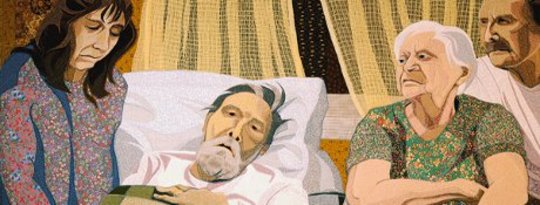
In the West, we place our cemeteries away from our everyday lives, as if there were an impermeable barrier separating life and death. We delude ourselves by pretending that death -- the elephant in the room -- will go away if we just ignore it.
In the Middle Ages, death was viewed as a natural, inevitable event. Life then was short, and the possibility of dying was always present. As we became technologically more advanced, death was delayed -- creating the illusion that we and our loved one could live indefinitely.
We have always known that this isn't true, but with a little effort the pretense can persist. However, the illusion comes with a price. Death becomes disconnected from life. It remains in the shadows and is spoken about euphemistically. It becomes a sharp point from which we recoil. And when it becomes imminent, we often don't know how to react.
Death Is Not a Solo Event
Death is not a solo event, confined to a single person. Rather, it is shaped by the dynamic interaction between the person who is dying and those who are not, by those who understand there’s little time left and, perhaps, by others who falsely believe life can be endless.
There is a saying that death is to living as the elephant is to the jungle; both leave the biggest footprint. Yet we in Western society treat death’s impending approach as if it had the impact of a squirrel’s footprint. We use words such as eternal sleep, going back home, passing away, crossing over, and many other phrases that attempt to soften the end of life.
Protecting Children from the Knowledge of Death?
As afraid as we may be, our fears become magnified when it comes to being honest with our children. We hide the knowledge that a loved one is dying, believing that our action will spare them emotional distress. And when they pointedly ask about the absence or condition of a relative, we often become as disfluent as if we were answering a young child’s question about how babies are made.
When Thomas Merton, the great Catholic theologian, was a child, in the 1920s, and his mother lay dying in a hospital only a few miles from where he was staying, he was never allowed to see her. The belief at the time was that it would be such a traumatic event that it would scar him for life. Their communication was limited to the exchange of letters.
Yet today little has changed. Many still look at death as if it were an embarrassing relative they would prefer didn’t attend family events. Unfortunately, we perpetuate our own discomfort or fear of death by transferring it to our children, and they to their children.
Death is an Ongoing Event
 Most people perceive death as a single event, analogous to a light switch — the light is on or it’s off; someone is alive, then they aren’t. But death is a process that spans time, beginning with a terminal prognosis and ending with the recovery of a caregiver’s joy. Some would argue that it begins with our first breath.
Most people perceive death as a single event, analogous to a light switch — the light is on or it’s off; someone is alive, then they aren’t. But death is a process that spans time, beginning with a terminal prognosis and ending with the recovery of a caregiver’s joy. Some would argue that it begins with our first breath.
How loved ones deal with it is analogous to a square dance where partners are continuously changing. But instead of other dancers, loved ones’ hands may be held by fears, beliefs, an unresolved past, and a nonexistent future. Into this scene step caregivers who want to help their loved ones. They learn that caregiving and death are far more complex than they anticipated.
The Balancing Act
Imagine standing on a small board that is balanced on a large ball. Your task is to stay upright. With each slight shift of your body, the ball moves and you need to readjust your balance. Now imagine that next to you is another person on a similar device, and the task for each of you is to hold on to the ends of a single stick. Your movements will affect the movements of the other person, and vice versa.
Having a progressive illness is like perpetually standing on that balance board. Just when a loved one begins to accept what is happening to him physically or emotionally, the ball moves and the balance he believed was established disappears. It can shift because the illness moves into a new phase or he has second thoughts about granting forgiveness to someone, or the pain he thought was controlled becomes so intense it makes thinking impossible, or his previous acceptance of his imminent or eventual death no longer looks tolerable, or the forgiveness he has been waiting for doesn’t come.
And all during these adjustments, you are there, still holding on to the end of the stick, both you and your loved one hoping not to pull the other down.
Defining the “Good Death”
Everyone would like his or her loved one to have a “good death,” whether it will occur in months or years. The question of what a “good death” is has been debated throughout history. When people are asked what the phrase means, their explanations are usually based on their values. It’s like when you ask people, “What is beauty?” Their answers are as diverse as the people you ask.
The son of a woman I served had a very simple definition of a good death: “Ideally, her death will come in her sleep and be quick and painless. She wouldn’t know what hit her.” While this type of death may be preferable, a significant number of deaths occur after a lingering illness. So, we’re still left with the question of what a good death is for people whose end isn’t instantaneous.
I’ve served a number of people whose deaths I thought were good, and others whose deaths I felt weren’t. Common to most good deaths was a psychological peacefulness that overshadowed physical pain. Two things that contributed to this peacefulness were the compassion expressed through the practical comforts provided by caregivers, and the loved one’s ability to tie up life’s loose ends.
Copyright © 2012 by Stan Goldberg.
Reprinted with permission of New World Library, Novato, CA.
www.newworldlibrary.com or 800/972-6657 ext. 52.
This article is adapted from the book:
Leaning Into Sharp Points: practical guidance and nurturing support for caregivers
by Stan Goldberg.
 Whether you’re coping with a loved one who has received a terminal diagnosis, has a long-term illness or disability, or suffers with dementia, caregiving is challenging and crucial. Those who face this responsibility, whether occasionally or 24/7, are brushing up against life’s sharpest point. In this book, Stan Goldberg offers an honest, caring, and comprehensive guide to those on this journey.
Whether you’re coping with a loved one who has received a terminal diagnosis, has a long-term illness or disability, or suffers with dementia, caregiving is challenging and crucial. Those who face this responsibility, whether occasionally or 24/7, are brushing up against life’s sharpest point. In this book, Stan Goldberg offers an honest, caring, and comprehensive guide to those on this journey.
Click here for more info and/or to order this book.
About the Author
 Stan Goldberg, PhD, has been a hospice volunteer and caregiver for many years. He has served more than four hundred patients and their loved ones at four different hospices, and was both a trainer and consultant. His previous book, Lessons for the Living, won the London Book Festival’s Grand Prize in 2009. He is a private therapist, clinical researcher, and former San Francisco State University professor. His website is stangoldbergwriter.com.
Stan Goldberg, PhD, has been a hospice volunteer and caregiver for many years. He has served more than four hundred patients and their loved ones at four different hospices, and was both a trainer and consultant. His previous book, Lessons for the Living, won the London Book Festival’s Grand Prize in 2009. He is a private therapist, clinical researcher, and former San Francisco State University professor. His website is stangoldbergwriter.com.




























